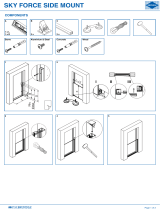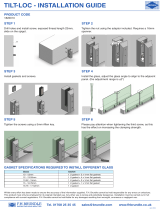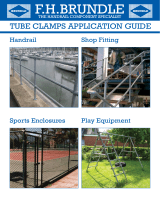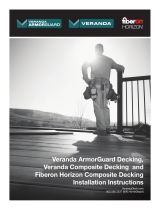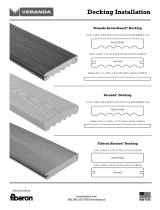
Apr 2022
Whilst every effort has been made to ensure the accuracy of the information supplied, F.H. Brundle cannot be held responsible for any errors or omissions.
This product must only be employed for its original intended use. Any other use is wrong and potentially dangerous. Installation must be carried out in full
compliance with current regulations. F.H. Brundle cannot be held liable for any damages resulting from wrongful, erroneous or negligent use.
CARE & MAINTENANCE
Composite building materials are virtually maintenance free, so very little care or maintenance is required. Here are some tips
to keeping your decking looking new:
Please note: You can use a pressure washer but do not use more than 1200 PSI or hold wand close to the deck surface
as this may cut into the surface of the deck causing unwanted scratches.
Mould and Mildew: The decking has an antifungal guard added during formulation and an additional antimicrobial surface
coating. This means your decking material is protected against mould, mildew and germs, including bacteria. We recommend
that you periodically clean your decking material by washing dirt and debris from the surface of the decking. Do not allow
twigs and other sources of microbes to build up between the boards. If mould or mildew develops, use a standard deck wash
containing calcium chloride. Spray on the solution in concentrated form to a slightly dampened deck surface. Allow 20 minutes
for the chemical to set and then simply wash off using a standard garden hose.
Heavy Stains: Staining may occur from oil, grease, dark wine, etc, damaging your deck surface. The rst action is to clean
the spot immediately. The best results will occur by cleaning immediately after the damage happens, before it soaks in to the
cellulose bre. If immediate cleaning is not possible, try to lift the stain from the surface using a degreaser or detergent in hot
water. If you are not satised with the result of either method use an all-purpose cleaner and non metallic scrubbing brush.
Ice and Snow: Always use a plastic shovel to remove snow from your deck surface. This will not scratch the surface like a
metal shovel. If you use a metal shovel, do not chip at the deck surface. Use salt to remove ice from the surface of your deck.
Salt will not cause harm or react with the composite formulation. Remove the salt from the deck surface when convenient. Note,
however, that prolonged exposure is not recommended.
Painting: The decking does not require any painting over the life of the product. If you want to change the colour of the
decking, railing, fencing or furniture products, use a paint recommended for surface coating applications. The paint will not
penetrate the surface of the material like traditional wood. Additionally, the paint will last much longer than it would with wood
due the fact that water does not penetrate the interior of the board causing the paint to lift from the surface. Always wait until the
surface area weathers before painting to provide more cellulose exposure for the paint to adhere to.
Please note: If you sand an area, it will not have the same grain pattern as the rest of the deck. Use a protective mat or plastic
caps to protect against constant metal contact from sources such as furniture legs, grills or planter stands. Constant metal
contact may produce rust stains.
Please note: Always test a piece of product before applying to the whole project to ensure that desired results are achieved.
Fire/Storm Damage/Renishing: The decking works well with a variety of deck stains. A custom formulation of colour-fast
properties allows you to recover and maintain the rich beauty of the original colour. The decking does fade to a slightly lighter
colour due to the bleaching nature of the natural cellulose bres contained within the product.
Miscellaneous: Always place concentrated heavy items where the deck board is contact with the joist substructure. Constant
loading of the deck board without support may cause the decking to sag. The decking is not recommended for structural
supports.
Page 5 of 5
Rinato installation manuals are designed as a general guide. They may not cover every installation scenario envisaged. Since each installation is unique; the
installation method used and/or the actual installation and its actual performance are the sole responsibility of the installer.





